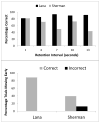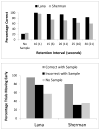Go when you know: Chimpanzees' confidence movements reflect their responses in a computerized memory task
- PMID: 26057831
- PMCID: PMC4500734
- DOI: 10.1016/j.cognition.2015.05.023
Go when you know: Chimpanzees' confidence movements reflect their responses in a computerized memory task
Abstract
Three chimpanzees performed a computerized memory task in which auditory feedback about the accuracy of each response was delayed. The delivery of food rewards for correct responses also was delayed and occurred in a separate location from the response. Crucially, if the chimpanzees did not move to the reward-delivery site before food was dispensed, the reward was lost and could not be recovered. Chimpanzees were significantly more likely to move to the dispenser on trials they had completed correctly than on those they had completed incorrectly, and these movements occurred before any external feedback about the outcome of their responses. Thus, chimpanzees moved (or not) on the basis of their confidence in their responses, and these confidence movements aligned closely with objective task performance. These untrained, spontaneous confidence judgments demonstrated that chimpanzees monitored their own states of knowing and not knowing and adjusted their behavior accordingly.
Keywords: Chimpanzees; Confidence judgments; Matching-to-sample; Memory; Metacognition.
Copyright © 2015 Elsevier B.V. All rights reserved.
Figures






References
-
- Adams A, Santi A. Pigeons exhibit higher accuracy for chosen memory tests than for forced memory tests in duration matching-to-sample. Learning and Behavior. 2011;39:1–11. - PubMed
-
- Balcomb FK, Gerken L. Three-year-old children can access their own memory to guide responses on a visual matching task. Developmental Science. 2008;11:750–760. - PubMed
-
- Benjamin AS, Bjork RA, Schwartz BL. The mismeasure of memory: When retrieval fluency is misleading as a metacognitive index. Journal of Experimental Psychology: General. 1998;127:55–68. - PubMed
Publication types
MeSH terms
Grants and funding
LinkOut - more resources
Full Text Sources
Other Literature Sources
Medical

